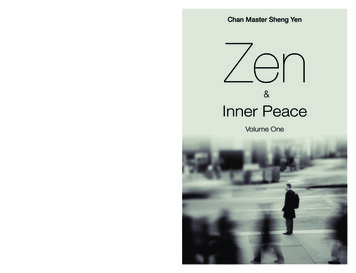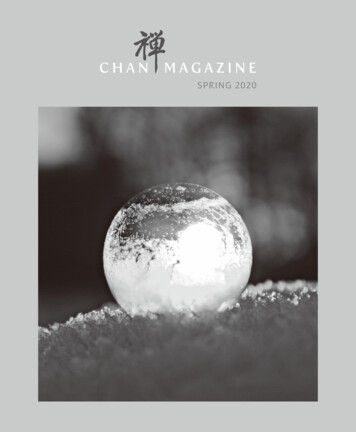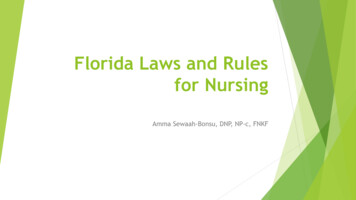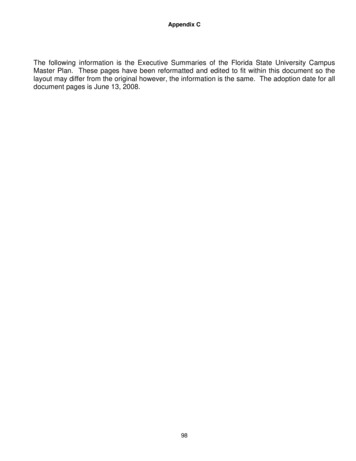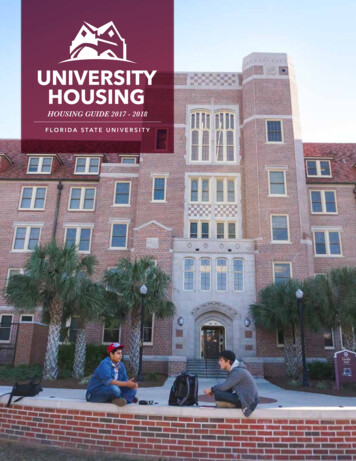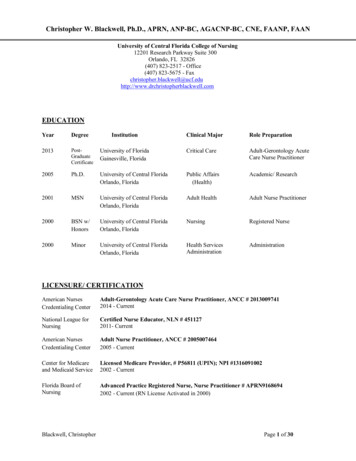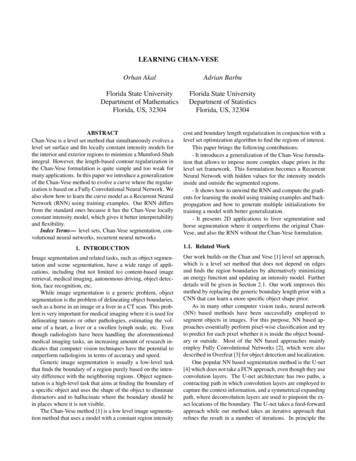
Transcription
LEARNING CHAN-VESEOrhan AkalAdrian BarbuFlorida State UniversityDepartment of MathematicsFlorida, US, 32304Florida State UniversityDepartment of StatisticsFlorida, US, 32304ABSTRACTChan-Vese is a level set method that simultaneously evolves alevel set surface and fits locally constant intensity models forthe interior and exterior regions to minimize a Mumford-Shahintegral. However, the length-based contour regularization inthe Chan-Vese formulation is quite simple and too weak formany applications. In this paper we introduce a generalizationof the Chan-Vese method to evolve a curve where the regularization is based on a Fully Convolutional Neural Network. Wealso show how to learn the curve model as a Recurrent NeuralNetwork (RNN) using training examples. Our RNN differsfrom the standard ones because it has the Chan-Vese locallyconstant intensity model, which gives it better interpretabilityand flexibility.Index Terms— level sets, Chan-Vese segmentation, convolutional neural networks, recurrent neural networks1. INTRODUCTIONImage segmentation and related tasks, such as object segmentation and scene segmentation, have a wide range of applications, including (but not limited to) content-based imageretrieval, medical imaging, autonomous driving, object detection, face recognition, etc.While image segmentation is a generic problem, objectsegmentation is the problem of delineating object boundaries,such as a horse in an image or a liver in a CT scan. This problem is very important for medical imaging where it is used fordelineating tumors or other pathologies, estimating the volume of a heart, a liver or a swollen lymph node, etc. Eventhough radiologists have been handling the aforementionedmedical imaging tasks, an increasing amount of research indicates that computer vision techniques have the potential tooutperform radiologists in terms of accuracy and speed.Generic image segmentation is usually a low-level taskthat finds the boundary of a region purely based on the intensity difference with the neighboring regions. Object segmentation is a high-level task that aims at finding the boundary ofa specific object and uses the shape of the object to eliminatedistractors and to hallucinate where the boundary should bein places where it is not visible.The Chan-Vese method [1] is a low level image segmentation method that uses a model with a constant region intensitycost and boundary length regularization in conjunction with alevel set optimization algorithm to find the regions of interest.This paper brings the following contributions:- It introduces a generalization of the Chan-Vese formulation that allows to impose more complex shape priors in thelevel set framework. This formulation becomes a RecurrentNeural Network with hidden values for the intensity modelsinside and outside the segmented regions.- It shows how to unwind the RNN and compute the gradients for learning the model using training examples and backpropagation and how to generate multiple initializations fortraining a model with better generalization.- It presents 2D applications to liver segmentation andhorse segmentation where it outperforms the original ChanVese, and also the RNN without the Chan-Vese formulation.1.1. Related WorkOur work builds on the Chan and Vese [1] level set approach,which is a level set method that does not depend on edgesand finds the region boundaries by alternatively minimizingan energy function and updating an intensity model. Furtherdetails will be given in Section 2.1. Our work improves thismethod by replacing the generic boundary length prior with aCNN that can learn a more specific object shape prior.As in many other computer vision tasks, neural network(NN) based methods have been successfully employed tosegment objects in images. For this purpose, NN based approaches essentially perform pixel-wise classification and tryto predict for each pixel whether it is inside the object boundary or outside. Most of the NN based approaches mainlyemploy Fully Convolutional Networks [2], which were alsodescribed in Overfeat [3] for object detection and localization.One popular NN based segmentation method is the U-net[4] which does not take a FCN approach, even though they useconvolution layers. The U-net architecture has two paths, acontracting path in which convolution layers are employed tocapture the context information, and a symmetrical expandingpath, where deconvolution layers are used to pinpoint the exact locations of the boundary. The U-net takes a feed-forwardapproach while our method takes an iterative approach thatrefines the result in a number of iterations. In principle the
U-net model can also be used as the CNN in our model (seeFigure 1), but that is subject to further exploration.Some recent work [5]-[6] merges level sets with deeplearning. Hu et al., [5] combines level sets with VGG16 [7]to segment out salient objects. The level set formulation ofactive contours is used in [6] along with optical flow for thetask of moving object segmentation.Recurrent Neural Networks (RNN) such as long shortterm memory (LSTM) networks [8] and Gated RecurrentUnits (GRU) [9] are widely and mostly used for sequentialdata such as in speech recognition, time series predictions,etc. However, this phenomenon is changing.Recent work employs RNNs for object segmentation orscene labeling. A first approach was introduced in [10] wherea CNN was used for scene labeling, and the model was trainedusing backpropagation through time (BPPT), similar to ours.However, they trained a loss function that evaluates the resultat each iteration, while our loss only evaluates the last iteration. More importantly, our model has hidden parameters forthe intensity models inside and outside the object, which isnot present in any RNN based approach.Reseg[11], has employed 4 RNNs to perform object segmentation in which the input image is divided into non overlapping patches. At each time step, vertical and horizontalfiltering layers sweep through a patch, then the system yieldsa new projection then updates the RNN and iterates over thenext patch. Unlike [11] we do not divide the image into subpatches and instead use the whole image in the recurrence.2. PROPOSED METHODThe problem that we are trying to address is how to imposebetter shape priors in the Chan-Vese formulation, and learnthese shape priors using training examples instead of settingthem by hand to a predefined form. Chen et al., [12] usedNNs as implicit solvers of differential equations. We proposethat we can learn the shape priors not by solving a PDE, butinstead by using CNNs to encode the shape prior, transforming the Chan-Vese evolution into a Recurrent Neural Network(RNN). Training the shape prior is done in an end-to-end fashion by backpropagation, but difficulties arise since all iterations of the RNN share the same weights, so special attentionmust be given to compute the gradient.2.1. Chan-Vese OverviewThe Chan-Vese Active contour [1] is fitted by minimizing thefollowing Mumford-Shah energy;ZZ2E(C) (I(u) µi ) du (I(u) µo )2 du ν C (1)CiCowhere I denotes the image intensity, C is the curve to be fitted, Ci , Co are the regions inside and respectively outside thecurve C, and µi and µo are the intensity averages of image Iinside and outside the curve C respectively.A direct approach would be to derive the Euler-Lagrangeequation and obtain a curve evolution equation of the formFig. 1. Our RNN model merging CNN with Chan-Vese C f (κ)N(2) twhere κ is the curvature of C, f is some function of the curva is the normal vector to the curve. However, suchture, and Na direct approach is difficult to implement because of topological changes such as self intersection of the curve makemanaging the curve representation quite challenging.The Chan-Vese approach takes a level set formulation instead. The curve C is represented as the 0 level set of a surfaceϕ, i.e. C {(x, y) ϕ(x, y) 0}. Usually ϕ(x, y) is initialized as the signed distance transform of C i.e. inside the curveC ϕ 0 and outside ϕ 0 and the magnitude of ϕ(x, y) isthe distance of the point (x, y) to the closest point on curveC. Then the energy (1) is extended to an energy of the levelset function ϕ:ZE(ϕ) (I(u) µo )2 (1 H (ϕ(u))) du ZZ(3)(I(u) µi )2 H (ϕ(u))du ν δ (ϕ(u)) ϕ(u) duwhere H is the smoothedHeaviside function 0if z (4)H (z) 1if z 1z1πzif z 2 [1 π sin( )]and δ is its derivative.Theparameterνcontrolsthe curveRlength regularization ϕ . When ν is small the curve (segmentation) C will have many small regions while when ν islarge, the curve C will be smooth and the segmented regionswill be large.This energy is minimized alternatively by updating µi , µoRRI(u)[1 H (ϕt (u))]duI(u)H (ϕt (u))du ttRµi R,µ ,oH (ϕt (u))du[1 H (ϕt (u))]du(5)then assuming µti , µto fixed the solution ϕ needs to satisfy theEuler-Lagrange equation: ϕδ (ϕ)[ν div() (I µto )2 (I µti )2 ] 0(6) ϕ 2.2. Our Model ϕDenoting κ(ϕ) div ϕ in (6), this can be accomplishedwith the following iterative update ϕt 1 ϕt ηδ (ϕt ) κ(ϕt ) (I µto )2 (I µti )2 (7)The curve C can always be obtained as the 0-level set ofφt , which can be done using the marching cubes algorithm.
This way topological changes are naturally handled by thelevel set function ϕ.We generalize the Chan-Vese formulation starting withthe Euler-Lagrange equation (6) and replacing the divergence ϕresponsible for the length regularizaterm κ(ϕ) div ϕ tion with a generic function g(ϕ, β) with parameters βδ (ϕ)[g(ϕ, β) (I µto )2 (I µti )2 ] 0(8)Minimization of the new model can be done with the following iterative algorithm, with or without the δ (ϕt ) factor,ϕt 1 ϕt ηδ (ϕt )(g(ϕt , β) (I µo )2 (I µi )2 ) (9)Instead of using a predefined function, we learn g(ϕ, β) as aConvolutional Neural Network (CNN). Because of the iterative update (9), the algorithm becomes a sort of RecurrentNeural Network that takes a preset number of steps T .In Figure 1 we can see that in each iteration our modeltakes ϕt as input and passes that through the CNN portion ofthe model which gives the shape information g(ϕt , β), whichis passed to the Chan-Vese update (9), along with average image intensity inside and outside of the curve C, µti , µto fromEq. (5). This way ϕt 1 is obtained and is fed back into thenext iteration of the RNN. After T iterations ϕT is thresholded to obtain the segmentation result.2.3. Training and BackpropagationOur model iterates a number T of times of the same updateequation (9), which means that our model has parameter sharing. Then the backpropagation becomes more challengingthan the models that don’t have parameter sharing. Following in the footsteps of Sun-Tappen [13], we used the chainrule to obtain the gradient of the loss function L with respectto the model parameters βTT 1T L X L ϕk L X ϕk Y ϕt 1 {··}. (10) β ϕk β ϕT β ϕtk 1t kk 1This is also illustrated in Figure 2. Using the the update (9)without the δ (ϕt ), we get ϕt 1 g(ϕt , β) µo (ϕt ) 1 η 2(I µo ) ·tt ϕ ϕ ϕt(11) µi (ϕt ),where 2(I µi ) · ϕttt µi (ϕ ) δ (ϕ )·(I µi ) µo (ϕt )δ (ϕt ) · (µo I)RR , ϕt ϕtH (ϕt (x))dx(1 H (ϕt (x)))dx(12)and H has been defined in Eq. (4) and δ is its derivative. Wealso get ϕt 1 g g ϕt 1 · η·(13) β g β βConsequentlyTT 1X L L g(ϕk 1 , β) Y ϕt 1 ·η·{·} (14) β ϕT β ϕtk 1t kt 1where ϕ ϕt is given in Eq. (11).Training. Training is done using triplets (Ii , Yi , Mi ) containing full input images Ii with corresponding desired segmentation maps Yi and initialization binary maps Mi . The initialFig. 2. For backpropagation, we unwind the model T timesand compute the gradient using Eq. (14).level set surface ϕ0 was obtained from each binary map Mias the signed distance transform.As loss function we used the Lorenz loss [14] for its robustness to outliers and ease of optimization (u) log(1 max(0, 1 u)2 )(15)The overall Lorenz loss for all training examples (Ii , Yi , Mi ),i 1, ., N isN XXL(β) (Ri (x, β)Yi (x))(16)i 1 x Yiwhere Ri (·, β) is the output ϕT obtained by our RNN withparameters β on image Ii with initialization Mi .When the number of iterations T is large, the loss (16)could have many local optima. To avoid getting stuck in ashallow optimum, we followed [15] and used the result of atrained RNN with fewer iterations as initialization. We therefore started with training a 1 iteration RNN, then used it asinitialization for the 2-iteration one, and so on.To be able to better handle local minima, we dynamicallychanged the learning rate by using an enlarged cosine wave,which is a modification of Huang et. al.’s [17] cosine annealing wave. However, unlike their formulation, the amplitudeof our cosine waveenlarged. is gradually π mod (i 1, n/r) α1 b i·rc i·r cosβ n 1 (17)αi 2n nwhere αi is the learning rate for the ith epoch, α1 is the largestpossible learning rate for which the gradient does not explode,β is augmentation factor for which we took β 1.25, n and rare number of epochs to be run and number of waves respectively.3. EXPERIMENTSWe implemented our model in MatConvNet [18] where wecreated new layers for the computation of µi , µo and for theChan-Vese update (9).CNN architecture. For CNN we used a network with twoconvolutional layers with 7 filters of size 7 7 with paddingfollowed by a convolutional layer with 7 filters of size 1 1 7 followed by ReLU and finally another convolutional layerwith one filter of size 1 1 7. The 7 7 filters used paddingsuch that the size of the output was kept the same as the sizeof the input.Multiple Initializations. In order for our model to generalize better we added for each input image I multiple initializations. One initialization was obtained the same way as itwill be obtained at test time. Other 10 initializations were obtained from the ground truth Y by the following distortions:
CV-1it CV-2it CV-3it CV-10it CV-100it CVNN-1it CVNN-2it CVNN-3itLiver Dataset90.85 91.07 91.20Weizmann horse dataset [16] 50.61 51.01 68.10Table 1. Dice coefficients on the test set obtained with 4-fold cross validation. ’CV - nit’ stands for standard Chan-Vese withn iterations, and ’CVNN - nit’ stands for our proposed method with n iterations.Fig. 3. Ground truth based initializations. Left: ground truth.Middle: distorted by added or punched semicircles at randomborder locations. Right: The middle image is corrupted byadding Gaussian noise and used as initialization for training.First, semicircles were added or holes were punched at random locations on the boundary of Y , then Gaussian noise wasadded to the distorted map around the edge. This process isillustrated in Figure 3.We trained various number of different initializations ofthe same image and observed that more initializations resultedin better generalization.Dataset. We used the Weizmann horse dataset [16] and themulti-organ dataset [19], from which we used all CT volumesthat were provided with a liver segmentation, for a total of17 volumes. A total of 11 slices have been used from eachvolume, at location z 100, 105, ., 150, for a total of 187images. The data was preprocessed by obtaining a rough liversegmentation with a CNN, an intensity histogram from insidethe rough segmentation, finally obtaining a liver likelihoodmap using the histogram only. The likelihood map and theinitial CNN segmentation were used as input for the methodsevaluated, and results are shown in Figure 4.Results. We report the results based on Dice coefficients[20]. Since the liver dataset is rather small, thus the resultsare shown with 4-fold cross validation. For the horse data weused 128 images for training and the remaining 200 imagesfor testing. In Table 1 are showed various number of iterations of the Chan-Vese algorithm and our model CVNN results on the Liver and Horse datasets. From the results it is obvious that even one iteration of our CVNN can perform aboutas good as 100 iterations of Chan-Vese. Considering computation time, CV-100 it takes 0.5 seconds per image, whileCVNN-3it takes 0.1 seconds per image on the liver dataset,so CVNN-3it is 5 times faster and obtains better results.Ablation study. We performed an ablation study to see thebenefit of including the intensity term (I µto )2 (I µti )2in Eq. (9), and what would happen if we added the imageintensity as another channel in the CNN, obtaining g(ϕ, I, β).The results for the liver data are shown in Table 2.It is clear that without the intensity model the accuracythat CVNN is no better than 1 iteration of CV. We can obtain aFig. 4. Segmentation results. Top: Chan-Vese with 100 iteration. Bottom: CVNN with 3 iterations.regular RNN by removing the intensity model and adding theimage I as a channel for the CNN. We see that this RNN doesbetter than without the intensity model, but no better than a10-iteration Chan-Vese. Finally, using the image as a channelfor CNN and adding back the intensity model gives anotherrise of 2% in accuracy, but still not as good as our proposedmethod that only uses the CNN for the shape.Update term in Eq. (9)DiceProposedg(ϕ, β) (I µto )2 (I µti )2 94.04No intensity modelg(ϕ, β)89.74Regular RNNg(ϕ, I, β)91.46Image I channel in CNN g(ϕ,I,β) (I µto )2 (I µti )2 93.42Table 2. Ablation study of the importance of the intensityterm (I µto )2 (I µti )2 in Eq. (9) and whether using theimage I as a channel in the CNN is useful or not.4. CONCLUSIONIn this paper we proposed a generalization of the Chan-Vesemethod that allows to learn a more complex shape model using a CNN instead of the generic boundary length prior fromthe original formulation. For this purpose we replaced thecurvature term from the Chan-Vese update with a CNN andshowed how to train it by back-propagation through time. Wealso showed how to generate multiple initializations for training in order to improve generalization of the obtained model.Experiments showed that one iteration of the proposed approach can obtain comparable results with 100 iterations ofChan-Vese, and more iterations further improve accuracy.In the future, we plan to extend the proposed approachto 3D data, where the Chan-Vese method is very computationally intensive. We also plan to extend the approach tomulti-organ segmentation.
5. REFERENCES[1] T Chan and L Vese, “Active contours without edges,”IEEE Transactions on Image Processing, vol. 10, pp.266–277, 2001.[2] Jonathan Long, Evan Shelhamer, and Trevor Darrell,“Fully convolutional networks for semantic segmentation,” in CVPR, 2015, pp. 3431–3440.[3] Pierre Sermanet, David Eigen, Xiang Zhang, MichaëlMathieu, Rob Fergus, and Yann LeCun, “Overfeat: Integrated recognition, localization and detection using convolutional networks,” arXiv preprint arXiv:1312.6229,2013.[4] Olaf Ronneberger, Philipp Fischer, and Thomas Brox,“U-net: Convolutional networks for biomedical imagesegmentation,” in MICCAI. Springer, 2015, pp. 234–241.[12] Tian Qi Chen, Yulia Rubanova, Jesse Bettencourt, andDavid K Duvenaud, “Neural ordinary differential equations,” in Advances in Neural Information ProcessingSystems, 2018, pp. 6571–6583.[13] Jian Sun and MF Tappen, “Learning non-local rangemarkov random field for image restoration,” in CVPR.IEEE Computer Society, 2011, pp. 2745–2752.[14] Adrian Barbu, Yiyuan She, Liangjing Ding, and GaryGramajo, “Feature selection with annealing for computer vision and big data learning,” IEEE Transactionson Pattern Analysis and Machine Intelligence, vol. 39,no. 2, pp. 272–286, 2017.[15] Adrian Barbu, “Training an active random field for realtime image denoising,” IEEE Transactions on ImageProcessing, vol. 18, no. 11, pp. 2451–2462, 2009.[16] Eran Borenstein and Shimon Ullman, “Class-specific,top-down segmentation,” in ECCV, 2002, pp. 109–122.[5] Ping Hu, Bing Shuai, Jun Liu, and Gang Wang, “Deeplevel sets for salient object detection,” in Proceedingsof the IEEE conference on computer vision and patternrecognition, 2017, pp. 2300–2309.[17] Gao Huang, Yixuan Li, Geoff Pleiss, Zhuang Liu,John E Hopcroft, and Kilian Q Weinberger, “Snapshot ensembles: Train 1, get m for free,” arXiv preprintarXiv:1704.00109, 2017.[6] Ping Hu, Gang Wang, Xiangfei Kong, Jason Kuen, andYap-Peng Tan, “Motion-guided cascaded refinementnetwork for video object segmentation,” in Proceedingsof the IEEE Conference on Computer Vision and PatternRecognition, 2018, pp. 1400–1409.[18] Andrea Vedaldi and Karel Lenc, “Matconvnet: Convolutional neural networks for matlab,” in Proceedings ofthe 23rd ACM international conference on Multimedia.ACM, 2015, pp. 689–692.[7] Karen Simonyan and Andrew Zisserman, “Very deepconvolutional networks for large-scale image recognition,” arXiv preprint arXiv:1409.1556, 2014.[19] Holger R Roth, Le Lu, Amal Farag, Hoo-Chang Shin,Jiamin Liu, Evrim B Turkbey, and Ronald M Summers,“Deeporgan: Multi-level deep convolutional networksfor automated pancreas segmentation,” in MICCAI,2015, pp. 556–564.[8] Sepp Hochreiter and Jürgen Schmidhuber, “Long shortterm memory,” Neural Computation, vol. 9, no. 8, pp.1735–1780, 1997.[9] Kyunghyun Cho, Bart van Merrienboer, Caglar Gulcehre, Dzmitry Bahdanau, Fethi Bougares, HolgerSchwenk, and Yoshua Bengio, “Learning phrase representations using rnn encoder–decoder for statistical machine translation,” in Conference on Empirical Methodsin Natural Language Processing (EMNLP), 2014, pp.1724–1734.[10] Pedro HO Pinheiro and Ronan Collobert, “Recurrentconvolutional neural networks for scene labeling,” inICML, 2014, number EPFL-CONF-199822.[11] Francesco Visin, Marco Ciccone, Adriana Romero,Kyle Kastner, Kyunghyun Cho, Yoshua Bengio, Matteo Matteucci, and Aaron Courville, “Reseg: A recurrent neural network-based model for semantic segmentation,” in CVPR Workshops, 2016, pp. 41–48.[20] Lee R Dice, “Measures of the amount of ecologic association between species,” Ecology, vol. 26, no. 3, pp.297–302, 1945.
LEARNING CHAN-VESE Orhan Akal Florida State University Department of Mathematics Florida, US, 32304 Adrian Barbu Florida State University Department of Statistics . the distance of the point (x;y) to the closest point on curve C. Then the energy (1) is extended to an energy of the level set function ': E (') Z I u) o 2(1 H )))du Z
